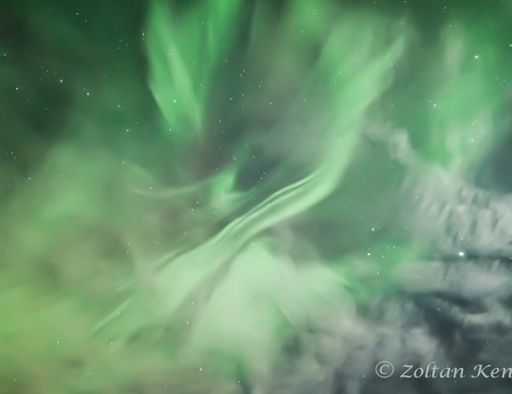
2014 SPACEWEATHER PAGES
JANUARY -
FEBRUARY, MARCH,
APRIL,
MAY,
JUNE,
JULY, AUGUST,
SEPTEMBER, OCTOBER, NOVEMBER,
DECEMBER

AURORA 2-9-14
MAGNETIC UNREST: Earth's magnetic field is still reverberating from the impact of a CME on Feb. 7th. Intermittent storming around the poles has produced bright auroras across Scandinavia, Iceland and Canada. Zoltan Kenwell sends this picture from Edmonton, Alberta:
Dee Finney's blog
start date July 20, 2011
today's date February 1, 2014
updated daily
page 642
TOPIC: SPACEWEATHER - FEBRUARY 2014
2-28-14
Solar wind
speed: 427.7 km/sec
density: 5.3 protons/cm3
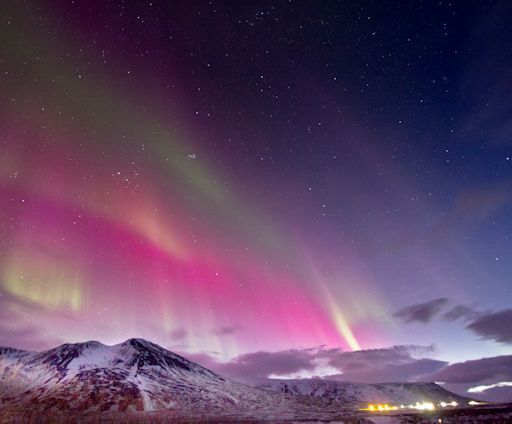
SUBSIDING STORM: A geomagnetic storm that started on Feb. 27th when a CME sideswiped Earth's magnetic field is subsiding. At its peak, the storm measured G2on NOAA storm scales and sparked bright auroras over northern Europe, Greenland and Iceland. Tryggvi Már Gunnarsson was driving out of Reykjavik when he saw the display:
"As I was driving from Reykjavik to north Iceland I saw this red halo on the sky. My first thought was: A volcano must be erupting!," says Gunnarsson. "Then, as the green colors appeared, I realized this was the aurora borealis. It was one of the most magnificent aurorashows I have ever seen."
If the magnetic storm had lasted just a little longer, bright lights would have appeared over some northern-tier US states, too. Instead, the display was rapidly fading by the time night fell over North America. High-latitude sky watchers should remain alert for auroras as Earth moves through the wake of the CME. NOAA forecasters estimate a 55% chance of resurgent storms on Feb. 28th
12 fireballs reported
2-27-14
Solar wind
speed: 442.5 km/sec
density: 11.4 protons/cm3
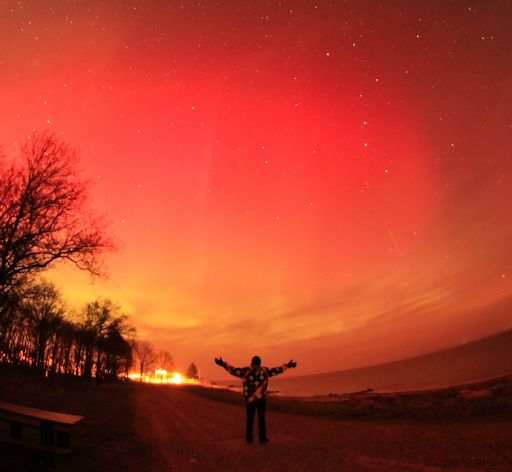
CME IMPACT TRIGGERS GEOMAGNETIC STORM: A moderate G2-class geomagnetic storm is in progress following the glancing impact of a CME on Feb. 27th at 1645 UT. Sky watchers in Europe are reporting bright auroras. Ruslans Merzlakovs sends this picture from Nykøbing Mors, Denmark:
"A very bright aurora splashed in the afternoon sky at 9 P.M. Danish time," says Merzlakovs. "This picture is a 30 second exposure at ISO 1600."
NOAA forecasters expect CME effects to last for as much as 24 hours. As night falls across North America, auroras could appear in northern-tier US states from Maine to Washington as well as Canada. Local midnight is usually the best time to look
7 fireballs reported
2-26-14
|
speed: 366.7 km/sec density: 2.0 protons/cm3 MORNING CONJUNCTION AND ECLIPSE: This morning, Venus and the crescent Moon converged for a beautiful sunrise conjunction. In some places, the conjunction was so tight that the Moon actually eclipsed Venus. Ravindra Aradhya sends this picture from Bangalore, India, taken moments before Venus disappeared behind the lunar limb: 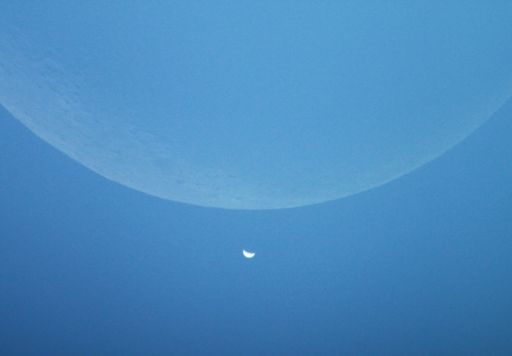 Like the Moon, Venus has phases, and today it was a 35% crescent. That's why the second planet looked like a "mini-Moon" through Aradhya's telescope. "A crescent Moon occulting a crescent Venus in morning daylight was an amazing sight," he says. Hundreds of photographers recorded the event. Browse the gallery for more views: |
2-25-14
Solar wind
speed: 373.1 km/sec
density: 2.2 protons/cm3
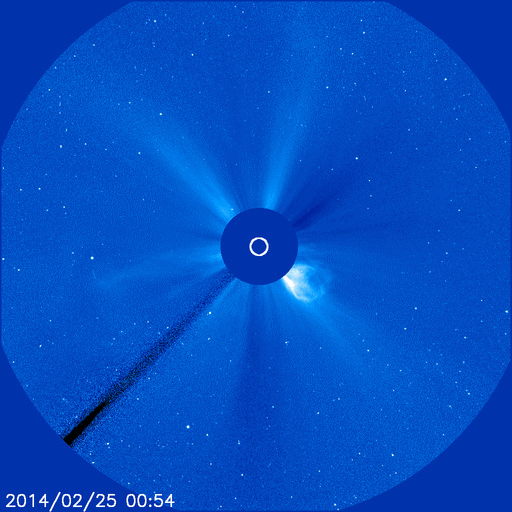
Coronagraphs onboard the Solar and Heliospheric Observatory tracked this material as it raced away from the sun, eventually forming a bright CME, pictured below.. Radio emissions from shock waves at the leading edge of the CME suggest an expansion velocity near 2000 km/s or 4.4 million mph. If such a fast-moving cloud did strike Earth, the resulting geomagnetic storms could be severe. However, because its trajectory is so far off the sun-Earth line, the CME will deliver a no more than a glancing blow. NOAA forecasters expect a weak impact late in the day on Feb. 26th.
4-fireballs reported
2-24-13
Solar wind
speed: 436.2 km/sec
density: 4.5 protons/cm3
GROWING CALM: The solar wind blowing around Earth is gusty and unsettled--probably a side-effect of one or more minor CMEs that swept past our planet over the weekend. This is sparking intermittent auroras around the poles, but no widespread geomagnetic storms. The forecast for the next 24-48 hours calls for growing calm
If AR1967 does come back, it will mark the third time the active region has crossed the visible face of the sun. The first time was in early January when it was called "AR1944." Sunspots seldom last more than two or three weeks; two or three months is remarkable. By now the returning spot is probably a decayed shell of its former self, although flares and CMEs flying over the southeastern limb hint at some remaining potency.
see picture above
4 fireballs reported
2-23-14
Solar wind
speed: 443.9 km/sec
density: 1.3 protons/cm3
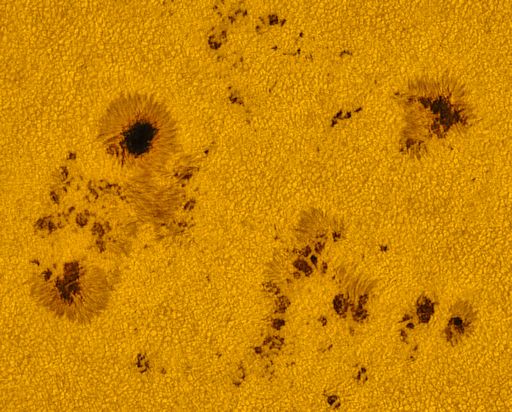
SPRAWLING SUNSPOT FACES EARTH: Occupying an expanse of solar terrain more than 280,000 km wide, sunspot complex AR1981-AR1982 is crossing the center of the solar disk, almost-directly facing Earth. This morning at the Langkawi National Observatory in Malaysia, astronomer Karzaman Ahmad photographed the behemoth:
Because it's so wide, the entire sunspot complex would not fit on the page. Click here to see the whole thing. Dozens of dark cores are present in Ahmad's image. The largest ones are about the size of Earth. Also note the fine granulation of the solar surface. Those are Texas-sized bubbles of plasma rising and falling around the sunspots like water boiling on top of a hot stove.
The magnetic canopy of AR1981-AR1982 harbors energy for significant eruptions. NOAA forecasters estimate a 50% chance of M-class flares and a 5% chance of X-class flares on Feb. 23rd.
4 fireballs reported
explanation | more
Updated:
2-22-14
Solar wind
speed: 433.9 km/sec
density: 3.1 protons/cm3
5 fireballs reported
2-21-14
Solar wind
speed: 461.7 km/sec
density: 2.6 protons/cm3
STORMY SPACE WEATHER: For the past two days, space weather around Earth has been stormy, a situation that might continue through the weekend. CMEs struck Earth's magnetic field on Feb. 19th and 20th, producing G2-class geomagnetic storms and auroras over more than half a dozen US States. Another CME is due on Feb. 21st followed by another on Feb. 22nd. The incoming CMEs are minor, but their combined impacts could add up to something more. NOAA forecasters estimate a 50% chance of polar geomagnetic storms on Feb. 21st
RAINBOW, TWISTED: On Feb. 18th, a heavy rain shower passed through the Thames Valley in the South East of England. When the clouds parted, local resident Christine Palmer wasn't surprised to see a rainbow appear--but something about this rainbow was a bit odd
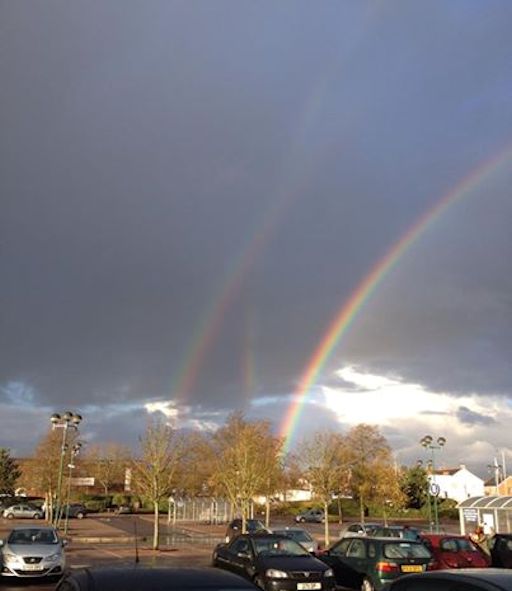
Many rainbows are double, but "this one was twisted as well," says Palmer.
The phenomenon is called a "reflection bow." Sunlight reflected from the wet ground was refracted by raindrops, forming a rainbow at odd angles from the primary rainbow arcing across the sky. "Floods in the area are extensive at the moment, so we have plenty of wet surfaces to form such reflections," she says.
Rain + sunlight = a rainbow. Rain + floods + sunlight = a reflection bow. When it'svery wet, be alert for both!
24 fireballs reported
2-20-14
Solar wind
speed: 511.3 km/sec
density: 1.2 protons/cm3
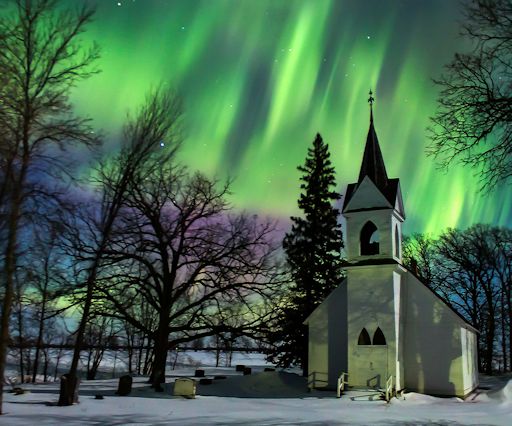
AURORAS OVER THE USA: A minor geomagnetic storm was already in progress during the early hours of Feb. 19th when a CME struck Earth's magnetic field. The impact revved-up the storm and sent Northern Lights spilling across the Canadian border into the United States. Jonathan Schiralli sends this picture from Grand Rapids, North Dakota:
To capture all the colors, Schiralli says he exposed the sky for 5 seconds using a Canon Rebel T3 digital camera set at 1600 ISO. Northern photographers should take note of those settings as more auroras are in the offing. NOAA forecasters estimate a 30% to 50% chance of geomagnetic storms on Feb. 20-21
3 fireballs reported
2-19-14
Solar wind
speed: 519.4 km/sec
density: 0.3 protons/cm3
2-18-14
Solar wind
speed: 408.8 km/sec
density: 10.9 protons/cm3
2-17-14
TOO QUIET FOR COMFORT
CNN) -- Only in space would 2 million miles be considered a close call.
An asteroid with an estimated diameter of three football fields zoomed by Earth late Monday, missing our home by about that distance.
It traveled at some 27,000 miles per hour.
The asteroid came just about a year after a relatively small asteroid blew up over Russia. The roughly 60-foot space rock plunged into Earth's atmosphere and exploded over the city of Chelyabinsk with the force of about 30 early nuclear bombs.
The blast left more than 1,500 injured, mostly by glass from shattered windows, and raised concerns about humanity's vulnerability to stray asteroids.
"On a practical level, a previously unknown, undiscovered asteroid seems to hit our planet and cause damage or injury once a century or so, as we witnessed on June 20, 1908, and February 15, 2013," said Bob Berman, Slooh host and astronomer.
Slooh.com tracks potentially hazardous objects, like asteroids and comets.
Berman added: "Every few centuries, an even more massive asteroid strikes us -- fortunately usually impacting in an ocean or wasteland such as Antarctica.
"But the ongoing threat, and the fact that biosphere-altering events remain a real if small annual possibility, suggests that discovering and tracking all NEOs (near-Earth objects), as well as setting up contingency plans for deflecting them on short notice should the need arise, would be a wise use of resources."
This asteroid is little different than half-a-dozen other space rocks that have already whizzed passed Earth at similar distances in February, including one, 2006 DP14, that is almost 4 times larger. The sudden attention to 2000 EM26 is disproportionate to its actual uniqueness or potential impact. For areal close encounter, click here.
CNN's Matt Smith contributed to this report.
'RADIOACTIVE' ERUPTION: On Feb. 17th at approximately 04:50 UT, a magnetic filament erupted from the sun's western limb. NASA's Solar Dynamics Observatory captured this high-resolution image of the blast:
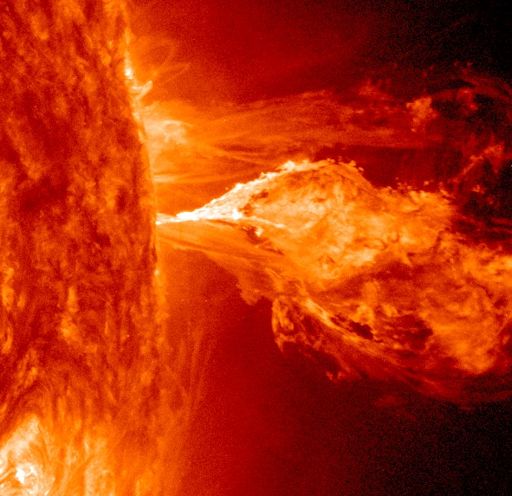
Because of its location on the sun's western limb, the eruption did not send a CME toward Earth. However, there was an effect on our planet: Shortwave radio loudspeakers roared with static, an event called a Type II radio burst.
Here's how it works: The explosion sent shock waves rippling through the sun's atmosphere. Those shock waves, in turn, triggered plasma instabilities in the solar corona that emit strong radio emissions. The static-y "roar" of the explosion was picked up by solar observatories and ham radio stations across the dayside of our planet. Based on the sweep of radio frequencies from 20 MHz to 500 MHz, analysts estimate a shock velocity of 776 km/s or 1.7 million mph. That may sound fast, but it is typical for this type of eruption
2-16-14
Solar wind
speed: 397.3 km/sec
density: 2.2 protons/cm3
STORM WARNING, CANCELED: A brief geomagnetic storm on Feb. 15th sparked by a CME impact has petered out, and the chances for auroras this weekend are subsiding. The CME appears to have been a merger of three minor clouds that, even together, could not cause a sustained disturbance in Earth's magnetic field. The hoped-for Valentine's display of auroras never materialized. Aurora alerts: text,voice
QUIETING SUNSPOT: After days of nonstop activity, big sunspot AR1974 is quieting. The sunspot's magnetic field appears to be losing some of its unstable complexity, prompting NOAA forecasters to downgrade the chance of an X-classflare today to only 5%. A beautiful sunset is more likely
2-15-14
Solar wind
speed: 375.6 km/sec
density: 3.4 protons/cm3
NEWS IS OMINOUSLY QUIET
2-14-14
Solar wind
speed: 340.9 km/sec
density: 0.8 protons/cm3
SOLAR ACTIVITY: Solar activity is at moderately high levels as five M-class solar flares and multiple CMEs were observed over the past 24 hours. The primary source is active sunspot AR1974, which has a 'beta-gamma-delta' magnetic field that harbors energy for strong explosions. NOAA forecasters estimate a 60% chance of M-flares and a 10% chance of X-flares on Feb. 13th. Solar flare alerts:text, voice
INCOMING CMES COULD SPARK VALENTINE'S LIGHTS: On Feb. 12th, an M-class exlosion in the magnetic canopy of sunspot AR1974 hurled a faint CME almost directly toward Earth.
4 FIREBALLS REPORTED
2-13-14
Solar wind
speed: 346.5 km/sec
density: 2.0 protons/cm3
AURORAS FOR VALENTINE'S DAY? Three CMEs are heading for Earth. Individually they are minor clouds. However, by striking Earth's magnetic field in quick succession on Feb 14-15, they could cause significant geomagnetic activity around the poles. High latitude skywatchers should be alert for auroras on Valentines Day when NOAA forecasters estimate a 60% chance of geomagnetic storms. Aurora alerts: text, voice
CHANCE OF FLARES: Growing sunspot AR1974 is crackling with M-class solar flares and poses a threat for even stronger X-class eruptions. Sergio Castillo sends this picture of the active region from his backyard observatory in Inglewood,CA:
Sunspot AR1974 looks really active with minor flare activity," says Castillo. "It hasn't unleashed a strong flare yet, but this can change at any time."
Indeed, the sunspot has a 'beta-gamma-delta' magnetic field that seems to be teetering on the edge of a significant flare. NOAA forecasters estimate a 60% chance of M-flares and a 10% chance of X-flares on Feb. 14th.
2-12-14
Two minor CMEs that left the sun on Feb. 11th are expected to merge and hit Earth's magnetic field on Feb. 14th. The combined impact could spark geomagnetic storms and auroras around the Arctic Circle on Valentine's Day. Aurora alerts: text, voice
INCREASING CHANCE OF FLARES: Sunspot AR1974 is growing rapidly and poses an increasing chance of Earth-directed flares.
During the past two days, the sunspot has sprouted dozens of new dark cores under an increasingly complex magnetic canopy. The region's unstable 'beta-gamma-delta' magnetic field harbors energy for strong explosions, prompting NOAA forecasters to boost the daily odds of M-flares to 45%, and X-flares to 10%. Solar flare alerts: text, voice
4 fireballs reported
2-11-14
Solar wind
speed: 458.2 km/sec
density: 7.4 protons/cm3
CHANCE OF EARTH-DIRECTED FLARES: Sunspot AR1974 is crossing the center of the solar disk and it is crackling with low-level flares. The active region has an unstable 'beta-gamma' magnetic field that harbors energy for Earth-directed eruptions. NOAA forecasters estimate a 30% chance of M-flares on Feb. 11th.Solar flare alerts: text, voice
4 fireballs reported
2-10-14
Solar wind
speed: 575.6 km/sec
density: 2.9 protons/cm3
JUPITER AND THE MOON: When the sun goes down tonight, step outside and look up. Jupiter and the gibbous Moon are only 5o apart--tight enough to fit inside the bowl of the Big Dipper. The bright conjunction is easy to see even from light-polluted cities. Take a look!
EMERGING SUNSPOTS: Over the weekend, active sunspots AR1967 and AR1968 rotated off the solar disk. However, the chance of flares has not decreased very much. Three new active regions have popped up to take their place:
AR1974 - AR1976, have 'beta-gamma' magnetic fields that harbor energy for medium-sized eruptions. And they are growing. NOAA forecasters estimate a 40% chance of M-class flares and a 5% chance of X-flares on Feb. 10th.Solar flare alerts: text, voice
4 fireballs reported
2-9-14
Solar wind
speed: 465.1 km/sec
density: 2.0 protons/cm3
GOOD-BYE SUNSPOTS, HELLO RADIATION STORM?: Today, big sunspots AR1967 and AR1968 are rotating over the sun's western limb to begin a two-week transit of the sun's farside. Ironically, this could result in elevated levels of radiation near Earth. At their current location, the two sunspots are well-connected to our planet by the sun's spiraling magnetic field. Any flares today could funnel energetic particles in our direction, possibly triggering a radiation storm. Solar flare alerts:text, voice
SEE PHOTO - TOP OF PAGE
2-8-14
Solar wind
speed: 409.7 km/sec
density: 2.1 protons/cm3
DECLINING CHANCE OF FLARES: Departing sunspots AR1967 and AR1968 are in a state of decay. Even so, both retain unstable magnetic fields that harbor energy for strong flares. NOAA forecasters estimate a declining but significant 60% chance of M-flares and a 20% chance of X-flares on Feb. 8th. Solar flare alerts: text, voice
CME IMPACT SPARKS AURORAS: A minor CME hit Earth's magnetic field on February 7th. The light show it produced was anything but minor. "BANG!" says Truls Tiller of Tromsø, Norway. "The sky exploded in auroras." In every direction he turned, he saw a scene like this:
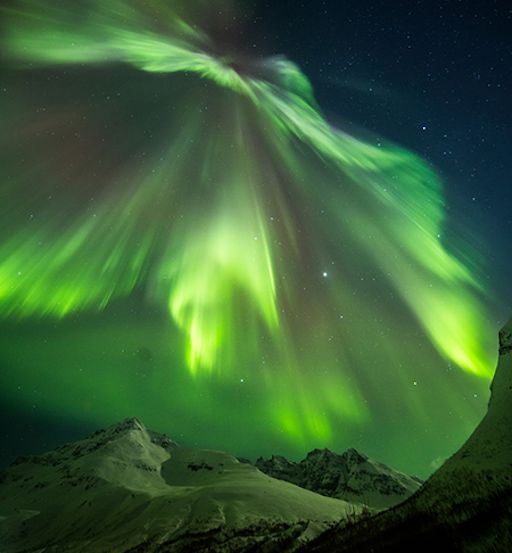
"I could hardly decide which direction to point my camera," he says. "The sky was filled with light for more than four hours."
More auroras are in the offing. A solar wind stream is expected to reach Earth this weekend even as Earth's magnetic field continues to reverberate from the Feb. 7th CME impact. NOAA forecasters estimate a 60% chance of polar geomagnetic storms on Feb. 8-9. Aurora alerts: text, voice
CURIOSITY PHOTOGRAPHS EARTH: Last year when the Cassini spacecraft photographed Earth through the rings of Saturn, the whole world was alerted to smile and wave. Last week, Curiosity did the same thing with less fanfare. Except for a few scientists, no one knew the Mars rover would be taking this picture of the Earth-Moon system on Jan. 31st:
2 fireballs reported
2-7-14
Solar wind
speed: 447.6 km/sec
density: 5.5 protons/cm3
CME IMPACT: A minor CME hit Earth's magnetic field today at aproximately 1700 UTC (noon EST). The impact caused electrical currents to ripple through the soil in parts of Scandinavia. High-latitude sky watchers should be alert for auroras in the hours ahead. Aurora alerts: text, voice
BIG SUNSPOTS: All week long, big sunspot AR1967 has has been crackling with activity, seemingly on the edge of producing an X-class solar flare. That hasn't happened. However, a new sunspot growing alongside AR1967 could push things over the edge. Emerging active region AR1968 has an unstable 'beta-gamma-delta' magnetic field that harbors energy for strong explosions. NOAA forecasters estimate an 60% chance of M-class solar flares and a 20% chance of X-class solar flares on Feb. 7th. Solar flare alerts: text, voice
2-6-14
Solar wind
speed: 364.7 km/sec
density: 0.0 protons/cm3
WEEKEND STORM WARNING: Polar geomagnetic storms are possible on Saturday, Feb. 8th, when a solar wind stream and a minor CME are expected to hit Earth's magnetic field. This will not be a major storm, but the double-impact could spark high-latitude auroras. Aurora alerts: text, voice
BIG SUNSPOTS, POISED TO ERUPT? All week long, big sunspot AR1967 has has been crackling with activity, seemingly on the edge of producing an X-classsolar flare. That hasn't happened. However, a new sunspot growing alongside AR1967 could push things over the edge. Emerging active region AR1968 has an unstable 'beta-gamma-delta' magnetic field. If it erupts, there could be a double-sunspot chain reaction. NOAA forecasters estimate an 60% chance of M-classsolar flares and a 20% chance of X-class solar flares on Feb. 7th. Solar flare alerts: text, voice
The two big sunspots were easy to see this evening when the sun set over Quezon City in the Philippines. Raymund Sarmiento photographed the gigantic duo:
AR1697 is so huge and prominent that you would not miss it asa large dark spot just right below the sun's disk on a clear sunset afternoon," says Sarmiento.
Caution: Even when the sun is dimmed by low-hanging clouds or haze, looking directly at the sun can damage your eyes. Looking through unfiltered optics is even worse. If you chose to photograph the low sun without filters, use the camera's LCD screen for viewfinding.
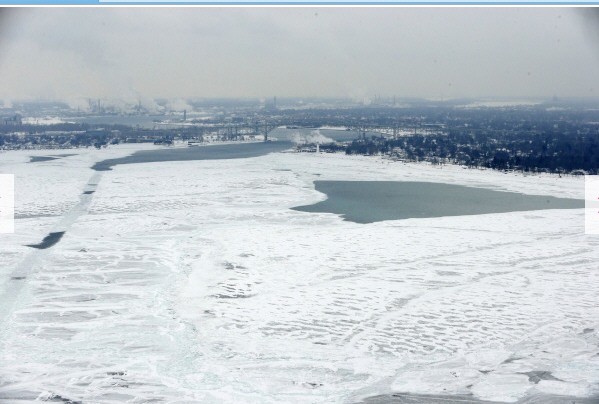
It's been so bitterly cold for so long in the Upper Midwest that the Great Lakes are almost completely covered with ice. The last time they came this close was in 1994, when 94 percent of the lakes' surface was frozen.
As of Friday, ice cover extended across 88 percent, according to the federal government's Great Lakes Environmental Research Laboratory in Ann Arbor.
Sections of the lakes, which hold nearly one-fifth of the freshwater on the world's surface, harden almost every winter. That freezing keeps the Coast Guard's fleet of nine icebreakers busy clearing paths for vessels hauling essential cargo such as heating oil, salt and coal. But over the past four decades, the average ice cover has receded 70 percent, scientists say, probably in part because of climate change.
Still, as this season shows, short-term weather patterns can trump multi-year trends. Winter arrived early and with a vengeance and refuses to loosen its grip.
"That arctic vortex came down, and the ice just kept going," said George Leshkevich, a physical scientist with the federal lab.
2-5-14
speed: 423.4 km/sec
density: 1.5 protons/cm3
WEAK IMPACT: A weak disturbance in the solar wind swept past Earth on Feb 5th at ~1400 UT. It may have been the long-overdue CME of Jan 31st, finally arriving after five days in transit. The weak impact did not spark a geomagnetic storm.Aurora alerts: text, voice
CHANCE OF FLARES: NOAA forecasters estimate an 80% chance of M-flares and a 50% chance of X-flares on Feb. 5th. The source would be giant sunspot AR1967, shown here seething with activity in a photo from amateur astronomer Sergio Castillo of Inglewood, California:

In Castillo's photo, a pair of magnetic filaments reaches out from the heart of the active region, where multiple dark cores big enough to swallow Earth are crackling with flares. "The activity in this region is just amazing," says Castillo.
AR1967 has an unstable 'delta-class' magnetic field that harbors energy for strong flares and CMEs. Any eruptions today will likely be Earth-directed as the active region is near the the center of the solar disk. Solar flare alerts: text, voice
6 fireballs reported. One was shown on television that people from 5 northeastern states saw all at the same time. That one had to have been very large and bright.
2-4-14
speed: 357.6 km/sec
density: 1.3 protons/cm3
See photo above.
APPROACHING CME: NOAA forecasters estimate a 25% chance of polar geomagnetic storms on Feb. 4th when a CME is expected to sideswipe Earth's magnetic field. The glancing impact could spark auroras around the Arctic Circle.Aurora alerts: text, voice
CHANCE OF FLARES: NOAA forecasters estimate an 80% chance of M-flares and a 50% chance of X-flares on Feb. 4th. The source would be giant sunspot AR1967, shown here seething with activity in a photo from amateur astronomer Sergio Castillo of Inglewood, California:
In Castillo's photo, a pair of magnetic filaments reaches out from the heart of the active region, where multiple dark cores big enough to swallow Earth are crackling with flares. "The activity in this region is just amazing," says Castillo.
AR1967 has an unstable 'delta-class' magnetic field that harbors energy for strong flares and CMEs. Any eruptions today will surely be Earth-directed as the active region crosses the center of the solar disk. Solar flare alerts: text, voice
6 FIREBALLS SEEN
2-3-14
speed: 338.1 km/sec
density: 1.6 protons/cm3
CME DELAYED: A CME expected to sideswipe Earth's magnetic field on Feb 2nd did not arrive on time. A new analysis by NOAA forecasters suggests it will reach Earth on Feb. 4th instead. The late arrival could spark minor geomagnetic storms and auroras on Tuesday. Aurora alerts: text, voice
BIG SUNSPOT, HIGH SOLAR ACTIVITY: Solar activity reached high levels yesterday with seven M-class solar flares and three CMEs. Almost all of the explosions were produced by monster sunspot AR1967, shown here in a Feb. 3rd photo taken by Karzaman Ahmad of the Langkawi National Observatory in Malaysia:

Click to view the entire sunspot. AR1967 is wider than the planet Jupiter and its primary dark cores are big enough to swallow Earth many times over. The scale of the thing makes it an easy target for backyard solar telescopes. "I used an 11-inch Celestron telescope with a Thousand Oaks White Light Filter," says Ahmad. "The sunspot is stunning and shows very interesting structural details even through a small telescope and whitelight filter."
AR1967 has a 'delta-class' magnetic field that harbors energy for strong eruptions. The growing complexity of the region has prompted NOAA forecasters to boost the odds of X-flares to 50% during the next 24 hours. Because AR1967 is near the center of the solar disk, any eruptions will be squarely Earth directed. Solar flare alerts: text, voice
0 FIREBALLS REPORTED
2-2-14
speed: 377.8 km/sec
density: 2.8 protons/cm3
INCOMING CME, CHANCE OF STORMS: Big sunspot AR1967 is crackling with solar flares and hurling CMEs into space. The biggest CME so far was propelled away from the sun on Jan. 30th by an M6-class explosion in the sunspot's magnetic canopy. It is expected to reach Earth on Feb. 2nd:
The blast was not squarely Earth-directed. Instead, it will deliver a glancing blow to our planet's magnetic field. NOAA forecasters estimate a 45% chance of polar geomagnetic storms when the cloud arrives on Sunday. High-latitude sky watchers should be alert for auroras. Aurora alerts: text, voice
5 fireballs reported
2-1-14
Solar wind
speed: 351.7 km/sec
density: 2.3 protons/cm3
Potentially Hazardous Asteroids (PHAs) are space rocks larger than approximately 100m that can come closer to Earth than 0.05 AU. None of the known PHAs is on a collision course with our planet, although astronomers are finding new ones all the time.
| Asteroid |
Date(UT)
|
Miss Distance
|
Size
|
| 2014 BM25 |
Jan 28
|
2.7 LD
|
10 m
|
| 2012 BX34 |
Jan 28
|
9.6 LD
|
13 m
|
| 2014 BK25 |
Jan 28
|
3.2 LD
|
14 m
|
| 2014 BX43 |
Feb 2
|
9 LD
|
30 m
|
| 2014 BW32 |
Feb 3
|
1.9 LD
|
23 m
|
| 2014 BP43 |
Feb 8
|
5.5 LD
|
20 m
|
| 2006 DP14 |
Feb 10
|
6.2 LD
|
730 m
|
| 2014 BT43 |
Feb 11
|
9.8 LD
|
31 m
|
| 2000 EM26 |
Feb 18
|
8.8 LD
|
195 m
|
| 2014 BR57 |
Feb 20
|
4.4 LD
|
73 m
|
| 2000 EE14 |
Mar 6
|
64.6 LD
|
1.8 km
|
| 2003 QQ47 |
Mar 26
|
49.9 LD
|
1.4 km
|
| 1995 SA |
Apr 2
|
73.1 LD
|
1.6 km
|
| 2000 HD24 |
Apr 4
|
42.2 LD
|
1.3 km
|